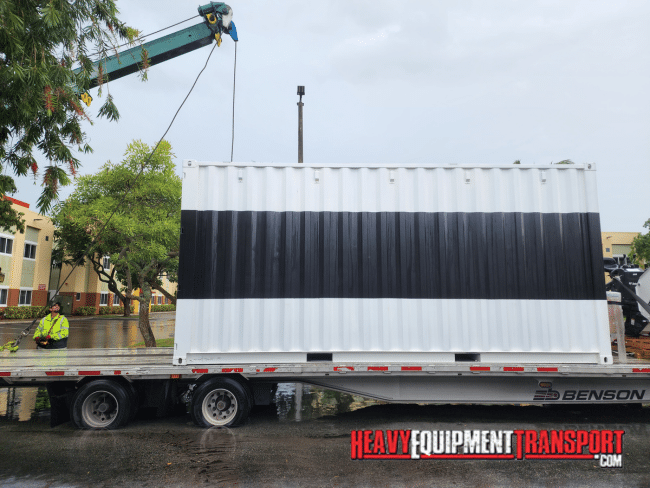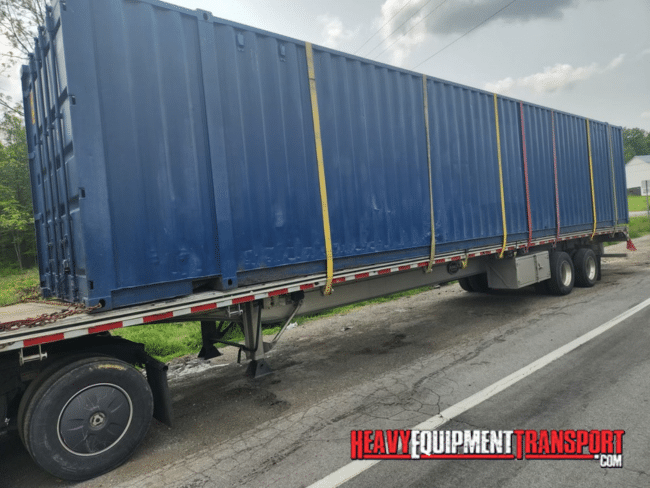Transporting a Loaded Shipping Container - What You Need to Know

Francisca Olive / June 2023
While moving a loaded shipping container may look simple, it calls for meticulous preparation and execution to minimize mishaps and delays. This article will cover the essentials of transporting a loaded shipping container.
Weight and Size Considerations of Loaded Shipping Containers
20-foot and 40-foot shipping containers are the most commonly used containers by transport companies. The maximum weight that may be safely transported in a 20-foot container is 28,000 pounds, whereas a 40-foot container can take up to 57,000 pounds. Nevertheless, a container’s maximum load-bearing capacity might change with time, condition, and manufacturer guidelines.
You should research weight limits for road, rail, and ocean transit when shipping a loaded container. In the United States, for instance, the combined weight of a vehicle and trailer transporting a loaded container should not exceed 80,000 pounds. A special permit may be needed if the weight exceeds the specified maximum.
In addition to weight considerations, there are also size limitations when transporting a loaded container. For instance, some highways and bridges may not be able to accommodate the height or width of certain containers. Sometimes this means finding another route or transportation mode.

Transport Your Container Today
Heavy Equipment Transport is always available for a quote. Fill out the form or give us a call now! (888) 730-2951
Factors to Consider When Selecting a Transportation Mode For Your Loaded Shipping Container
While deciding on a means of transportation, it is crucial to consider the total distance the container will travel and its final destination. Transport by sea, for instance, is the best choice for overseas shipments, whereas transport by land, such as by road or rail, might be better for interstate or local shipments.
The size and weight of the cargo are major factors in determining the most appropriate mode of transport. Air and road transport are best for small, fragile shipments, whereas water transport is preferable for heavy goods. The degree to which the goods are hazardous, delicate, or valuable is another factor that determines the transportation mode used. High-value, easily damaged items are best shipped via air or land.
Cost is another major consideration. Rail transport is the most cost-effective option when transporting large or bulky goods across a long, inland distance. Road transport (most commonly trucks) is the most cost-effective option when shipping a few items over a short inland distance since it eliminates the need for packaging and handling. Water transport is the cheapest means of transportation but also the slowest; it is best suited for transporting large or bulky products across great distances when time is not a consideration. Air freight is the way to go for shipping perishable, delicate, or important items, despite being the most expensive alternative.
The safety of the cargo is also an important consideration when deciding on a mode of transportation. Since road transport losses are lower than rail travel, it is the favored mode of transportation. The dangers of the sea and the higher transit time make ocean freight the least secure mode of transport.

Challenges and Risks Associated with Transporting Loaded Containers
➤ Poor Handling
Handling involves picking, packing, loading, and unloading cargo. And in many cases, careless handling is the root cause of mishaps resulting in slips, trips, and potential financial losses. For instance, if you are shipping fragile items, there is always a risk of damage during transport if the proper precautions are not taken. Because of the many hands that touch a product throughout the transportation process, it is more likely to sustain damage due to carelessness or accident (such as being dropped by a delivery driver or mishandled while being unloaded).
➤ Weight and Size Issues
Oversize or overweight shipments can cause issues. If the container exceeds the weight and size limitations for a specific mode of transport, special permits may be required, which can lead to delays and increased expenses.
➤ Theft
Cargo robbers prey on loaded containers at transit hubs, parking lots, and other locations where the cargo is left unattended. Though robbers are known to steal goods directly, occasionally, personnel with knowledge from the “inside” also get engaged in this cargo theft operation by supplying transportation information to others. Besides these more obvious methods, hijacking, piracy, and cyber-attacks are frequently used by criminals to gain access to networks and steal valuable goods.
➤ Compliance Issues
Transporting hazardous materials or cargo that requires special handling can be challenging due to regulatory compliance issues. Failure to comply with regulations can result in penalties, fines, and even legal action.
Key Takeaway
Transporting a loaded shipping container requires careful planning and consideration of various factors such as weight and size, transport mode, costs, and compliance issues. To guarantee the timely and secure delivery of your cargo while keeping expenses to a minimum and maximizing efficiency, you must mitigate the dangers and difficulties inherent in moving a loaded shipping container.

William Thomas
Heavy Transport Specialist
Being able to lead a team of such talented logistics agents has been a wonderful experience over the past ten years. If you would like to know anything more about the heavy equipment transport services we offer, don't hesitate to give us a call!